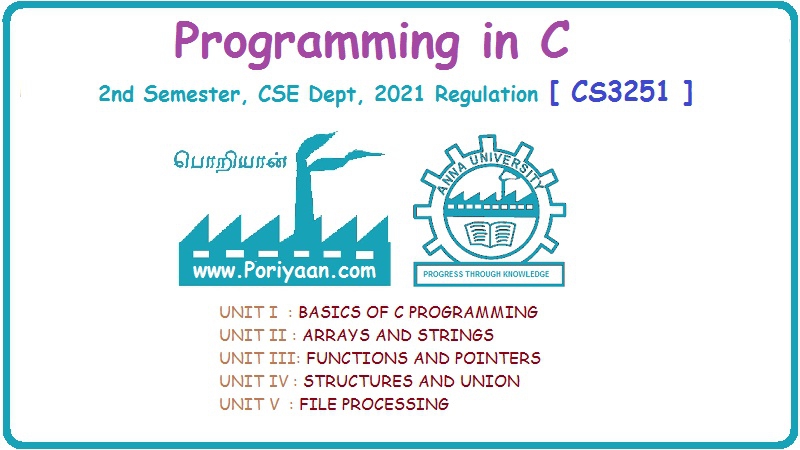Programming in C: Unit II (a): Arrays
Accessing the Elements of an Array in C
with Examples
For accessing an individual element of the array, the array subscript must be used. For example, to access the fourth element of the array, we must write arr [3].
ACCESSING THE ELEMENTS OF AN ARRAY
For
accessing an individual element of the array, the array subscript must be used.
For example, to access the fourth element of the array, we must write arr [3].
The subscript/ index must be an integral value or an expression that evaluates
to an integral value.
Programming Tip:
To
access all the elements of the array, you must use a loop. There is no single
statement that can do the work.
Although
storing the related data items in a single array enables the the programmers
develop concise and efficient programs, there is no single function that can
operate on all the elements of the array. To access all the elements of the
array, we must use a loop. That is, we can access all the elements of the array
by varying the value of the subscript into the array. But note that the
subscript must be an integral value or an expression that evaluates to an
integral value. As shown in Figure 5.2, the first element of the array marks [10] can be accessed by writing,
marks [0]. Now to process all the elements of the array, we will use a loop as
shown in Figure 5.3.

The
code accesses every individual element of the array and sets its value to -1.
In the for loop, first the value of marks [0] is set to -1, then the value of
the index (i) is incremented and the next value, i.e., marks [1] is set to -1.
The procedure is continued until all the 10 elements of the array are set to
-1.
Note
There
is no single statement that can read, access, or print all the elements of the
array. To do this, we have to do it using a for/while/do-while loop to execute
the same statement with different index values.
Calculating the Address of Array Elements
You
must be wondering that how C knows where an a individual element of the array
is located in the memory.
The
answer is that the array name is a symbolic reference to the address of the
first byte of the array. When we use the array name, we are actually referring
to the first byte of the array.
The
subscript or the index represents the offset from the beginning of the array to
the element being referenced. With just the array name and the index, C can
calculate the address of any element in the array.
Since
an array stores all its data elements in consecutive memory locations, storing
just the base address, i.e, the address of the first element in the array is
sufficient. The address of other data elements can simply be calculated using
the base address. The formula for doing this calculation is:
Address of data element, A[k] =
BA(A) + w (k-lower bound)
Here, A is the array, k is the index of the element for which we have to calculate the
address, BA is the base address of
the array A, w is the word size of
one element in memory (for example, size of int is 2), and lower_bound is the index of the first element in the array.
Example 5.1
Given an array int marks[ ] = {99,
67, 78, 56, 88, 90, 34, 85}. Calculate the address of marks[4] if base address
= 1000.
Solution

We
know that storing an integer value requires 2 bytes, therefore, word size is 2
bytes.
Address
(Marks [4]) = 1000+ 2(4 – 0)
=
1000 + 2 (4) = 1008
Example 5.2
Given an array, float avg[ ] =
(99.0, 67.0, 78.0, 56.0, 88.0,90.0, 34.0, 85.0). Calculate the address of avg
[4] if base address = 1000.
Solution

We
know that storing a floating point number requires 4 bytes, therefore, word
size is 4 bytes.
Address
(Avg [4]) = 1000+ 4 (4 – 0)
=
1000+ 4 (4)
=
1016
Note
When we write arr[i], the compiler
interprets it as the contents of memory slot which is i slots away from the
beginning of the array arr.
Calculating the Length of an Array
Length
of the array is given by the number of elements stored in it. The general
formula to calculate the length of the array is:
Length = upper_bound - lower bound
+ 1
where
upper bound is the index of the last element and lower_bound is the index of
the first element in the array.
Usually,
lower_bound is zero but this is not a compulsion as we can have an array whose
index may start from any non-zero value.
Example 5.3
Let Age [5] be an array of integers
such that
Age [0] = 2 Age [1] = 5 Age [2] = 3
Age [3] = 1 Age [4] = 7
Solution
Show
the memory representation of the array and calculate its length.
Memory
representation of the array Age is as given
Ppppppppppppppppp
Length
= upper_bound lower_bound + 1
Here,
lower bound 0, upper_bound = 4
Therefore,
length = 4 - 0 + 1 = 5
Programming in C: Unit II (a): Arrays : Tag: : with Examples - Accessing the Elements of an Array in C
Related Topics
Related Subjects
Programming in C
CS3251 2nd Semester CSE Dept 2021 | Regulation | 2nd Semester CSE Dept 2021 Regulation
